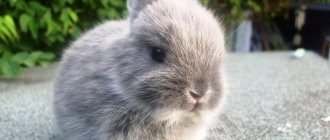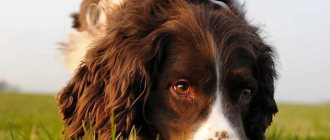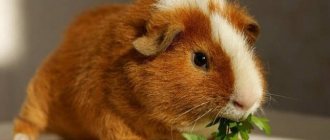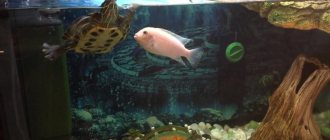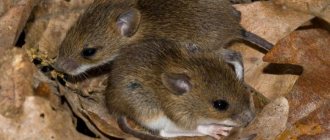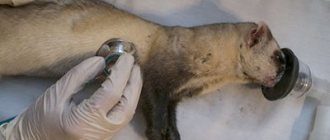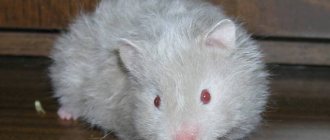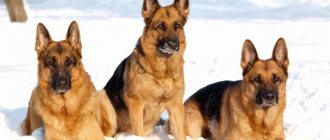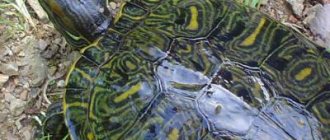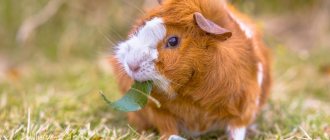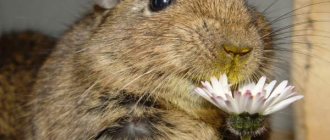Pets are found in almost every home. The decorative rabbit is rapidly gaining popularity. These animals do not need walks outside, take up little space, and are very easy to care for.
However, before you get such a pet, you should find out how long the animal lives, what to feed it and how to properly maintain it. The average life expectancy of dwarf rabbits is 6-12 years.
INTERESTING! The diet of such animals consists of vegetables, grains, fruits, twigs, hay, and licks. They especially love watermelons, sweet apples, carrots, and cucumbers.
PS. Prices are indicated with a wide range and are approximate. Much depends on where to buy a rabbit, under what conditions, availability of documentation, vaccinations and other important points.
Hermelin red-eyed and blue-eyed
There are two varieties of hermelin: with red or blue eyes. The first appeared at the end of the 19th century. Blue-eyed hermelines were obtained at the beginning of the 20th century. Initially, a weight of 750 grams was considered ideal, but in such females fertility was noticeably reduced.
Characteristic:
- Weight: 1100-1350 g.
- Ear length: 3.5-7 cm, straight.
- Wool: medium.
- Color: white.
- Price: 4-10 t.r.
In 1992, Austria released a new standard in which the weight of animals was changed. Hermelines have a strong build. The body is cylindrical, the limbs are short. The coat must be white.
How many years do decorative rabbits live?
The average lifespan of domestic rodents is 8-10 years. Dwarf rabbits live a little less - 7-8 years. Much depends on the conditions in which the animal is kept. With good care, long-eared pets rarely die before the allotted time.
The lifespan of an animal is influenced by the following factors:
- Lifestyle. The rabbit needs to move a lot. Physical activity will help speed up your metabolism and avoid weight gain.
- Diet. Rabbits have a sensitive digestive system, so it is important to monitor your pet's diet.
- Conditions of detention. The rodent must be protected from hypothermia, overheating, temperature changes, and dampness, otherwise it may get sick and die.
- Castration. Veterinarians say that spayed and neutered rabbits live on average 1-2 years longer.
Read in detail about “How long do decorative rabbits live?”
A caring owner can prolong the life of his pet. What is needed for this:
- keep the animal in a spacious cage;
- feed correctly, do not give prohibited foods;
- Vaccinate your rabbit in a timely manner;
- monitor the cleanliness of the rodent’s body and home;
- protect him from stressful situations.
We recommend the article “How to properly feed domestic rabbits.”
The approach of old age is indicated by changes in the behavior of the decorative rabbit. Over time, his activity decreases, he ceases to be interested in games. In older animals, their fur thins, their eyes become cloudy, and their muscles weaken. But we must remember that in old age a pet needs the love and care of its owner even more.
Colored dwarf
The breed was founded by the German breeder Hoffmann. By 1957, he had received a fairly large population of different colors: Marder, black, gray, Siamese, blue, etc. This breed is distributed throughout the world and is the most numerous.
Peculiarities:
- Weight: 1000-1500 g.
- Ears: 5.5 cm, straight.
- Coat type: medium.
- Any colour.
- How much does it cost: 3-7 tr.
The body of a colored dwarf has the shape of a cylinder. The front legs are short, the head is quite large, but short. The coat is shiny, medium length, thick. There should be no dewlap. Any color is allowed.
Colored dwarf Dutch
A breed that was obtained in the Netherlands. It was officially recognized in 1940. To obtain it, they used hermelins and local small rabbits. Such animals appeared in Russia in 2013.
Characteristic:
- Weight: 800-1300 g.
- Ear length: 5-7.5 cm, straight.
- Wool: medium.
- Color: any.
- Price: 2-7 t.r.
Small rabbits whose weight should not exceed 1300 grams. The head has a rounded shape. The muzzle is wide, the eyes are round and large. The ears are located close to each other. The limbs are short and adjacent to the body.
A little history of the formation of a line of rabbits with the dwarfism gene
In the second half of the 19th century, breeders began to actively use small silver rabbits for breeding, which have a special gene that ensures small size offspring. Already in 1870, the first dwarf breed was registered in England: the Polish white downy mini rabbit (Britain Petit). In 1920, German breeders introduced the world to a completely new breed - the curly-furred Hermelin. In 1930, colored dwarfs were bred in Holland, and the breed standard was approved in 1940. Dwarf lop-eared rabbits appeared at exhibitions in 1952, and the breed was registered in 1964. The newest among all is the lion-headed dwarf, bred at the beginning of this century. The authorship of this breed of dwarf rabbits is disputed by the Belgians and Americans.
The “best” mini-rabbits – interesting facts
Before describing the breeds, we would like to present to your attention some interesting facts about these funny animals.
- The smallest dwarf rabbit from the USA, registered in the Guinness Book of Records, weighed only 400 g. Although a female weighing 297 g now lives in Chelyabinsk and her owners have applied for the record.
- The rabbit has the longest ears - 79.06 cm.
- The longest life a domestic rabbit has lived was 19 years and 2 months.
On average, dwarf breeds live 7-9 years, and this depends only on the quality of care for the animal, and not on what species it belongs to.
Netherland dwarf rabbit
The ancestor of the breed is the red-eyed Hermelin. They have spread throughout the world. These rabbits were brought to Russia from Finland in 2014. There are two lines of the breed: English and American.
Peculiarities:
- Weight: 900-1150 g.
- Ears: 5-7.5 cm, straight.
- Coat type: medium.
- Any colour.
- Cost: 4-8 tr.
The ideal weight of an adult Netherland rabbit is 950 grams. The body is compact, the body has a rounded short format. The length of the ears varies from 5 to 7.5 cm. The breed standard includes 37 colors: solid, agouti, Siamese, tan, etc.
Features of the view
Buyers often confuse the concepts of “dwarf” and “decorative”. These words cannot be called synonyms at all. Any rabbit that is kept as a pet is considered decorative.
Dwarfs are small fluffy creatures. Such animals comply with the breed standard and have strictly acceptable colors.
Polish rabbit or Dwarf hare
This dwarf rabbit is considered the smallest of all decorative breeds. Such animals came to Russia only in 2014. The most common Polish rabbits are in England and Scandinavian countries.
Characteristic:
- Weight: 500-1400 g.
- Ear length: 5-6 cm, straight.
- Wool: medium.
- Color: any.
- Price: 7-15 t.r.
Outwardly, these rabbits resemble a wild hare. The head is light and egg-shaped. The legs are long, thin, adjacent to the body. The coat is thick and about 2 cm long. Polish rabbits should not have dewlaps.
Common diseases
Decorative dwarf rabbits are fragile and delicate creatures, susceptible to stress and a large number of diseases. However, with proper care and timely contact with a veterinarian, almost any ailment can be treated.
Owners need to be careful and alert if:
- the animal hides, hides in a corner and other places unusual for it;
- the coat looks disheveled and dull and begins to shed;
- appetite worsens;
- there is diarrhea or constipation;
- discharge appears from the eyes or nose.
At the first alarming symptoms, it is better not to self-treat, but to immediately show your pet to a veterinarian
Stomach upset
The most vulnerable part of a rabbit’s body is the stomach. Therefore, any disturbances in the animal’s diet can lead to digestive disorders, primarily diarrhea.
Stomach upset is most often caused by:
- eating moldy bread or dry food;
- entering the diet of food affected by pests, for example, weevils;
- sudden change in diet;
- eating excess amounts of vegetables and fruits;
- viral infections;
- pathologies of the digestive system;
- unsanitary conditions in the cage.
As first aid for diarrhea, you can do the following:
- Give the animal a chamomile solution prepared according to the instructions. Dilute the resulting product at the rate of 0.5 tbsp. l. decoction for 1 tbsp. l. water and give three times a day for a week. If the rabbit refuses to drink on its own, you can forcefully pour the product into the mouth using a syringe without a needle.
- Clean and disinfect the cage well. Lay down new bedding.
- Remove all food, vegetables and fruits from the diet, feed only hay and give water.
If the diarrhea does not go away within one or two days, you should immediately consult a veterinarian.
Paralysis
Paralysis often affects the hind limbs and lower spine. The rabbit becomes inactive and lies on its side. This condition leads to constipation and poses a high risk to the life of the animal.
It is known that the disease is easier to prevent than to treat. For the purpose of prevention, it is necessary to ensure that the rabbit does not jump from a height (sofa, table and other furniture), and also does not slip on a smooth surface. In addition to traumatic causes, paralysis can be caused by a lack of vitamins and microelements, as well as infectious diseases. At the first symptoms of the disease, you should consult a specialist.
Rhinitis
As mentioned above, rabbits are very sensitive to drafts and do not tolerate unfavorable environmental conditions. Due to decreased immunity, bacteria develop in animals' bodies, causing runny noses and sneezing. Long-term illness leads to profuse discharge from the eyes and nose, weight loss, and loss of shine in the coat.
From the following video you can learn how and with what to treat a runny nose in rabbits:
Dwarf rex
The first dwarf rexes appeared in France in 1919. They differ from other breeds in having very short hair. It is velvety and “plush” to the touch. Another feature is a short and curly mustache.
Peculiarities:
- Weight: 1000-1500 g.
- Ears: 3.5-7 cm, straight.
- Coat type: short.
- Any colour.
- Cost: 5-10 tr.
The Rex's body is stocky, compact, and slightly elongated. The length of the coat does not exceed 17-18 mm. It grows vertically and should not be curly or wavy. When stroking, the hairs return to their original position. The head is short, rounded, large. The eyes are large and expressive.
Satin dwarf
An American breed of rabbits with a special guard hair structure. It has a hollow shaft that reflects light well and gives the wool a unique shine. The first mutation occurred in 1934, after which these animals began to be purposefully bred.
Characteristic:
- Weight: 1500-2200 g.
- Ear length: 6-9 cm, straight.
- Wool: medium.
- Color: white, black, chocolate, red, chinchilla, Siamese, otter, opal.
- Price: 2-9 t.r.
A dwarf variety of satin rabbits was obtained not so long ago. Their body is slightly elongated, their back is rounded. The peculiarity of satin rabbits is their shining and iridescent fur, thanks to which it is impossible to confuse these animals with other breeds.
Taming and raising rabbits
Adult dwarf rabbits are quite intelligent animals. Proper training and education can make them real artists. When a pet appears in the house, it must first be tamed. Do not cuddle or carry the animal in your arms. Let the baby first master the territory and get used to the new environment. To make him feel better, you need to give him something tasty. When the rabbit eats, you can pet it lightly. You can raise an animal only when it feels confident in a new place.
After the little rabbit has become comfortable, you can begin further taming and training. The first step is to accustom your pet to the tray. You don't need to install it right away. In the first days, keep track of where the animal goes to the toilet. Then take some litter with excrement and place it in the tray. Place a feeder next to the litter tray; rabbits often eat and eliminate at the same time. But you need to make sure that they do not stain the food.
Small decorative rabbits can be trained to their nickname. Take a treat in your hand and call your pet by name. First he will follow the smell of food, and then he will develop a conditioned reflex to the nickname. In the same way, rabbits are taught to jump through hoops or other obstacles. They place a treat on one side and push the animal on the other. If the baby responds to his nickname, you can simply call him.
Fox dwarf rabbit
These animals were bred in Germany. To obtain them, ordinary medium-sized fox rabbits were crossed with miniature Hermelines, and dwarf Angora rabbits were also used to lengthen their fur.
Peculiarities:
- Weight: 1110-1250 g.
- Ears: 4-6.5 cm, straight.
- Coat length: medium-long.
- Any colour.
- Cost: 3-7 tr.
The fur of fox rabbits is thick and quite long (from 3.5 to 5 cm). It feels very soft and silky to the touch. The body is cylindrical, strong, and well-knit. The legs are short, the head is round and large.
Accommodation features: rabbit house
If you decide to get rabbits and create a mini-farm in the village, then at the first stage you need to take care of their place of residence. A ready-made room for a rabbitry is created or used. The animals will be housed more compactly in 2-tier cages. Keeping rabbits indoors is more convenient and rational. Drafts and dampness, prolonged exposure to the sun should be avoided, but ventilation should be provided.
Outdoor home cage option
For a pet, the cage is placed away from heating appliances. If you raise a rabbit in a hot room, the rabbit will experience constant thirst and its health will worsen. It is not recommended to keep him in a cage all the time. In order for the indoor pet to feel good, it is allowed to run around the apartment.
Longer stay for pets - their cage
Keeping an animal’s “house” clean is an important condition for its health. Dirt and urine cause diseases of the respiratory system and eyes, so the tray is cleaned three times a week
Once a week, wash thoroughly using disinfectants.
Portable cage option
Feeders, drinking bowls, and hay mangers should be placed in the cage. They need to be well secured so that the animals cannot spill water or contaminate the food. They need to be washed as often as possible.
Animals love to eat indoor flowers. It is necessary to remove poisonous plants from the apartment, install the rest on cabinets or hang them in flower pots.
Is it possible to keep rodents together with chickens? Their cohabitation is possible only if there are no other options. Although they are completely different species, they have common diseases. In addition, the “eared” ones feel uncomfortable in the company of noisy and hectic hens. Therefore, keeping chickens and rabbits together is not recommended.
Lion-headed dwarf rabbit
These animals were the result of a genetic mutation and appeared from crossing the Belgian dwarf and Swiss fox breeds. Subsequently, breeders used Angora dwarfs to improve the quality of the wool of lion-headed rabbits.
Characteristic:
- Weight: 850-1500 g.
- Ear length: 4.5-6 cm, straight.
- Coat: medium, long on the head.
- Color: any.
- Price: 5-9 t.r.
The peculiarity of such rabbits is very long hair around the ears and on the cheeks, forming a characteristic “mane”. At the same time, the hairs on the body do not exceed 3-5 cm in length. These animals are very common; they can be found more often than others in apartments and houses.
How to toilet train an animal
Accustoming a baby rabbit to a litter tray requires a lot of patience from the owner.
The little rabbit is gradually getting used to the toilet, but you will have to be a little patient. It is advisable to remember in which corner the breeder had the tray and place it there at home. It is worth asking the breeder for some used litter and mixing it with the old one. The pet will quickly find its native smell.
If the baby doesn't get into the tray, there's no need to swear. As soon as it becomes noticeable that your pet wants to go to the toilet, you must immediately put him in the litter tray. After a job done successfully, the animal should be praised. If you patiently train your pet to use the toilet day after day, the result will be achieved.
Dwarf Angora
The first dwarf angoras appeared in Russia in 1997. They were brought from Poland. Breeders began active work to improve the breed and received a large group of animals with the same pubescence and body weight.
Peculiarities:
- Weight: 900-2000 g.
- Ears: 5-7.5 cm, straight.
- Coat length: very long.
- Color: white (with blue or red eyes), Siamese, yellow, black, blue, Havana, etc.
- Cost: 5-15 tr.
Outwardly, the Angora rabbit resembles a fluffy cloud. The fur of these animals is long and grows vertically. The head is very well pubescent, so the animals have almost no nose or eyes visible. These animals require regular grooming.
Reproduction
For most owners, the issue of breeding decorative rabbits is not relevant. It is enough that one pet lives at home.
When choosing the sex of an animal, you should take into account that males are more aggressive and impulsive than females. The urine of males has a very unpleasant odor, especially noticeable when they exhibit the instinct to mark territory. To exclude the latter, it is necessary to take care of timely castration .
Rabbits are known for their fertility. Therefore, if you decide to breed animals, with proper care you can get up to 8 litters per year. As a rule, representatives of decorative and dwarf breeds are able to become parents from 6-7 months of age. Pregnancy lasts 31 days. During this period, caring for the rabbit does not change much, but the diet should be diversified by adding foods rich in vitamins to the diet.
Dwarf ram
Dutch breed of domestic dwarf rabbits. To obtain it, ordinary French large rams were used. These animals are distinguished by their flexible disposition. They are quite phlegmatic, rarely show aggression, and are easy to keep.
Characteristic:
- Weight: 1400-2000 g.
- Ear length: 24-28 cm, drooping.
- Wool: medium.
- Color: any.
- Price: 10-15 t.r.
Small rabbits with long floppy ears. The head is round with large eyes and a wide, slightly flattened forehead. Rams have a wide back, a rounded back, and a strong and well-built physique.
REFERENCE! These animals are prone to gaining excess weight, so food should be given to them in portions and in limited quantities.
Pros and cons of content
Dwarf rabbits are affectionate and clean, but very susceptible to disease
There are advantages and disadvantages to owning these small, cute animals. Let's start with the pros:
- Cleanliness. Dwarf long-eared cats quickly become accustomed to the litter box, and there is very little litter from them in the apartment.
- These are affectionate, kind pets that immediately become attached to their owners. When they are happy, they click their teeth funny and make pleasant sounds.
- Rabbits are unpretentious in care and nutrition, and their maintenance is quite inexpensive.
The main disadvantage of animals is their pain. They can fall ill not only from infection, but also from sadness. Frequent visits to the veterinarian can take a lot of effort and time. Another disadvantage is the problem of constantly gnawing on something. Buying toys will help solve the problem: the rest of the things in the house will remain intact.
It is also worth considering that each rabbit, despite its small stature, is a personality. They are very touchy and remember bad treatment for a long time.
Dwarf rex ram
To obtain these animals, such breeds of decorative rabbits as dwarf lop-eared rams and rexes were used. Breeding work began at the beginning of the 21st century. These animals appeared in Russia only in 2007. They were officially recognized in 2015.
Peculiarities:
- Weight: 1700-1900 g.
- Ears: 24-28 cm, hanging.
- Coat length: short, plush.
- Any colour.
- Cost: 7.5-20 t.r.
Quite rare and very beautiful animals. The body is of medium length, the head is rounded, slightly elongated. Fold-eared rex rams have round, expressive eyes and long ears. On the head there is a “crown” characteristic of the breed. The coat is short, velvety and plush to the touch.
Training and playing with your pet
Decorative rabbits just love to play
Dwarf rabbit breeds love to play and can learn some interesting tricks. They perceive training not as coercion, but as an opportunity to have fun. To achieve success, you need to eliminate negativity and aggression from the educational process. The best assistants in training will be praise and treating your pet with treats.
You should not start training your baby immediately after purchase. We need to give him a couple of months to adapt, after which he can begin training.
Lion-headed dwarf ram
To obtain such animals with an unusual appearance, dwarf rams and lion-headed rabbits were used. The breed was officially recognized in 2007 in the UK. In Russia this happened in 2010.
Characteristic:
- Weight: 1600-2200 g.
- Ear length: 24-27 cm, drooping.
- Coat: medium, long on the head.
- Color: any.
- Price: 4.5-12 t.r.
The lion-headed ram has a dense, cylindrical body. The ears are long, hanging, rounded at the ends. The coat on the body is of medium length, but around the ears and on the cheeks it is noticeably longer (up to 15-18 cm).
Where is the best place to buy a dwarf rabbit?
First of all, decide on the gender and breed of your future pet, and also make sure that you can provide it with proper care and maintenance.
You can buy a dwarf rabbit at a pet store, in a special nursery, or by hand. The last option is the most unreliable; instead of a purebred rabbit, they may give you an ordinary one with defects. A pet store also has its drawbacks - sellers may have poor knowledge of breeds and will not tell you the basic rules for care.
The best option is a dwarf rabbit nursery. Here, future owners will receive advice from professionals, official documents and a pedigree of a guaranteed healthy rabbit of the desired breed.
Dutch lop-eared dwarf rabbit
The first representatives of the breed were obtained about 30 years ago. To breed them, breeders crossed Dutch rabbits and French fold rams. For several years, experts have been working to reduce the size of the breed.
Peculiarities:
- Weight: 1250-1700 g.
- Ears: 21-26 cm, hanging.
- Coat length: medium.
- Color: brown, gray, black, blue, marten, isabella, black otter, chinchilla.
- Cost: 3.5-8 tr.
The body of these animals is strong, the back is rounded. Skin without folds, dewlap is not allowed. The head is quite large and round in shape. The neck is short. The eyes of Netherland rabbits are large and expressive.
Caring for a cat after castration in the first hours
After castration, a cat needs special care. Most veterinary clinics provide post-operative hospital services. In a special box with optimal climatic conditions, the operated pet is observed until it completely recovers from anesthesia. Once convinced that the cat’s condition is satisfactory, it is handed over to its owners.
Care in the first hours after castration comes down to monitoring your pets
If such a service is not available in the clinic or castration is performed at home, it is important to follow the following care recommendations:
To transport a cat after castration, it is recommended to use a loose carrier with a folding top and an absorbent diaper on the bottom. It is forbidden to transport an operated pet in your arms or in a car seat, as when waking up from anesthesia, it can harm itself or its owner. During transportation and further postoperative stay, the cat is placed on its side; It is recommended to lay an anesthetized, operated cat on the floor, since when it comes to its senses, it may fall off the table/sofa/bed. A common symptom of anesthesia sleep is uncontrollable urination. Using an absorbent diaper placed on the floor under the pet will make it much easier to eliminate such a nuisance; During anesthetized sleep, body temperature drops by 1-1.5°, so to prevent hypothermia, the operated pet is placed next to a heating radiator. It is strictly forbidden to place animals near electrical appliances with an open heating element. Instead of a battery, you can use a heating pad or a plastic bottle with hot, but not boiling water, which is placed next to the cat under a bedding or blanket
It is important that the heat does not come into contact with the cat's perineum, as this will cause bleeding. During the warm season, no additional warming procedure is required; for a more comfortable awakening from anesthesia sleep, it is recommended to close the curtains on the windows, since bright sunlight causes irritation of the optic nerve; Anesthesia sleep lasts from 15 to 120 minutes. depending on the method of administration and dose of the drug
During this time, it is necessary to monitor the cat so that it does not bury its nose in anything and suffocate. In addition, cats in this condition do not blink, which can cause the cornea to dry out. It is recommended to drip sterile saline solution, contact lens liquid, or eye drops without antibiotics into the eyes several times;
A protective collar will prevent your pet from licking the wound, further irritating it.
- Often waking up after anesthesia causes aggression in the pet. Therefore, it is recommended to provide the cat with complete rest for 24 hours, limiting access to him by other animals or children. It is forbidden to forcefully wake up your pet. Depending on the individual characteristics, after waking up, the cat may experience an unsteady gait, vomiting, involuntary urination, and a lethargic and drowsy state. This condition can last up to 8 hours, which is normal and should not cause concern;
- the wound on the scrotum after castration is not sutured, so it is recommended to minimize the amount of filler in the tray or replace it with absorbent paper. This will prevent the ingress of small filler particles and subsequent complications;
- A few hours after surgery, there may be slight bleeding from the incision, which is normal and safe for the cat. You can lightly dry the wound with a gauze cloth. In case of significant bleeding of more than 1 ml, you should urgently contact the doctor who performed the operation;
- Medicines prescribed by a veterinarian will help relieve pain. You can tell that a cat needs pain medication by dilated pupils, meowing, pursed paws, and aggression when attempting contact;
- You can prevent the possibility of damage to the healing incision by the cat’s rough tongue during hygiene by wearing a protective collar around the neck for several days. Such a product will limit the cat’s access to the wound without affecting food intake in any way.
Note! Veterinarians recommend castration in the fall or winter months, as during this period the likelihood of infection of the incision during rehabilitation is lower. In the summer, as a preventive measure for infection, the doctor prescribes a 5-day course of antibiotic treatment.
Mini lop
The breed was bred in Germany. These animals were obtained by crossing Dutch fold rams and dwarf chinchillas. The first mini-lops were white, but later other colors were obtained. The breed was officially recognized in 1980.
Characteristic:
- Weight: 1400-2700 g.
- Ear length: should be 2-3 cm below the jaw, drooping.
- Wool: medium.
- Color: any.
- Price: 8-17 t.r.
Mini lop has a strong body. The head is rounded and quite large. The neck is very short. The limbs are thick, not curved, and short. These rabbits are very good-natured, so even small children can communicate with them without any problems.
Maintenance at the dacha
With the onset of spring, many owners begin to travel outside the city to their dachas. Before taking your pet with you on a trip, carefully weigh the pros and cons. Remember that rabbits are not only cute in appearance, but also extremely gentle animals. Therefore, it is not recommended to transport them from place to place unless absolutely necessary. They do not tolerate stuffiness and heat well, and air conditioning can cause colds. Stress will also have a detrimental effect on your pet’s well-being. Therefore, if your stay at the dacha is short (up to five days), it is better to leave the rabbit at home.
When keeping a pet at your dacha, take care to protect it from other animals.
Being in nature is fraught with many dangers, so you should adhere to the following recommendations:
- limit contact of the fluffy with other animals, for example, dogs, cats, birds;
- make sure that your pet does not dig up and eat the roots of plants, for example, tulips, daffodils or peonies, that contain substances that are toxic to him;
- install a portable enclosure, placing it in the shade and covering it with netting.
Mini lop lionhead
These animals were obtained in England in the early 2000s, but they are not yet officially recognized. The best representatives of the lion-headed dwarf and mini lop breeds were used for breeding.
Peculiarities:
- Weight: 1500-1600 g.
- Ears: 21-25 cm, hanging.
- Coat length: medium, long in the head area (up to 7.5 cm).
- Any colour.
- Cost: 6-13 tr.
These animals are quite miniature. A characteristic feature of the breed is a very thick mane on the head, while the hair on the body is short (no more than 2 cm). The body is dense, strong, the back is rounded. Lion-headed mini-lops have a round head proportional to the body.
Difference from sterilization
Castration of rabbits is an operation as a result of which they are deprived of the opportunity to have offspring. Spaying rabbits is sometimes called neutering, but there is a significant difference between the two. Since sterilization does not involve resection of any organs, the ability to reproduce disappears, but the natural desire to mate remains.
Sterilization of rabbits involves bandaging. In this case, the reproductive organs are ligated - in females the fallopian tubes, and in males the seminal ducts. The behavior of animals during certain periods remains aggressive and unpleasant.
Unlike sterilization, castration of rabbits immediately solves all problems that have arisen. The result of castration of rabbits is the absence of pregnancy. Their behavior also changes - they stop falling into a state of hunting, that is, the natural desire to mate disappears. Even during the mating season, their behavior continues to remain calm.
The essence of castration of rabbits is to cut off the ovaries in females and the testicles in males. You can have your rabbit castrated by professionals or by yourself.
Mini lop cashmere (long-haired)
The first long-haired rabbits were obtained by chance in a litter of standard dwarf rams. This happened in 1980 in England. It was these animals that became the founders of the Cashmere Mini Lop breed.
Characteristic:
- Weight: 1300-1600 g.
- Ear length: 20-24 cm, drooping.
- Coat: long (from 3.8 to 5-6 cm), shorter on the head.
- Color: any.
- Price: 7.5-13 t.r.
Cashmere mini lop has a dense, strong, but small body. The croup is rounded. The neck is very short, almost invisible. Both the forelimbs and hind limbs are thick and short. The peculiarity of the breed is its long, soft, but not plump, hair that is always straight.
Won't they grow up like meat ones?
I am often asked about the size of dwarf rabbits, some are afraid that they will be very large, like meat rabbits, and others want an adult palm-sized rabbit, so I decided to make a brief overview of the parameters of different breeds of rabbits.
As we can see in the photo above, even the largest dwarf rabbits will never approach the size of meat breeds. The maximum weight of a lop-eared rabbit is 2 kg, while meat rabbits weigh 5 kg or more, that is, their meat counterpart is at least 2-3 times more. So, we should not forget about the character of the animals, the selection of dwarfs is carried out not only by size, but also by the character of the animals, they must be kind to humans and not have bad habits. While meat rabbits are selected only for productive qualities and good manners, this is not a prerequisite for admission to breeding.
Holland lop
This breed is the result of crossing Dutch dwarf rams and French lops (the weight of these rabbits reaches 4.5 kg). It was officially recognized in America in 1979.
Peculiarities:
- Weight: 1400-1800 g.
- Ears: 12 cm, drooping.
- Coat type: medium.
- Color: fawn, silver, chocolate, white, brown, red.
- Cost: 8-14 tr.
A distinctive feature of Holland Lop rabbits is their almond-shaped ears. Their average length is 12 cm. The body of rabbits is muscular, strong, and the back is rounded. The legs are short and thick, very strong.
Breeds of dwarf rabbits are numerous and varied. At home, they are kept both in cages and freely. They do not require complex care, and most of them have a good-natured and easy-going character.
Care and maintenance at home
Keeping long-eared pets is not particularly difficult. It is important to choose a healthy animal and prepare a suitable room for it. It should be well ventilated, but without drafts. Heat is also contraindicated for rabbits; they cannot be placed near a radiator.
It is better to buy a cage with galvanized metal rods. Two males will not get along in it, but females or rabbits of different sexes can be placed together. Of course, the size of such a house should be larger.
Many breeders are afraid of unpleasant odors. If you properly care for animals, they will not exist. At the bottom of the cage, it is necessary to pour bedding from pieces of newspapers, sawdust or straw in time. These materials absorb odors well and can be quickly removed.
Long-eared dogs with thick hair need to be brushed regularly. In addition, approximately once every 3 weeks your pet needs to have its claws trimmed.
What to feed a dwarf rabbit
Dwarf rabbits can eat up to 30 times a day
Dwarf rabbits are big eaters: they eat up to 30 times per day. The owners must provide them with adequate nutrition and not restrict food, otherwise they can harm the digestive system. The food that the animal eats is quickly digested and reaches the intestines only after the next meal.
A pet's diet should be varied. It is better if it is based on ready-made balanced food from pet stores. You can also give hay. If the eared dog refuses to eat it, the hay is slightly moistened with water and salt.
The menu must be supplemented with grass, including meadow grass, as well as bone meal and chalk - a long-eared animal cannot do without minerals. It is useful to give oats or wheat soaked in water, fresh fruits and vegetables.
Important: You can give cabbage, which rabbits love, but red cabbage is contraindicated for them.
Sometimes rabbits eat the waste left in the cage. There is no need to be afraid of this: they are harmless to long-eared animals.
Hygiene and bathing
You should only bathe babies if they are very dirty.
Since dwarf rabbits are very clean, there is no need for regular bathing. But if the baby gets very dirty at home or on a walk, it is better not to let him clean himself, but still give him a bath. The rest of the time, you should not expose your baby to stress. He will take care of his own skin, which is also replaced with a new one every six months.
Diseases and treatment
Vaccines and vaccinations are necessary for dwarf rabbits. These gentle creatures, even in comfortable room conditions, can catch a disease such as a cold or conjunctivitis. Both hypothermia and heat stroke are equally dangerous for them. Timely vaccinations will protect rabbits from infections and dangerous diseases such as rabies.
Therefore, the condition of pets must be constantly monitored. The following symptoms may indicate the disease:
- Vomiting, nausea, bloating.
- Loose stools or constipation.
- Belching, rumbling in the stomach, bad breath.
- Fatigue, lethargy, drowsiness.
Even if there are one or two symptoms, the baby should be shown to the veterinarian: delay can be disastrous for him.
Vaccination
The smallest rabbits are protected from diseases by maternal immunity. When they switch to adult food, the body weakens. Vaccinations can begin as early as the sixth week. Animals are vaccinated against rabies, salmonellosis, listeriosis and some other diseases.
Before vaccination, you need to prepare: take care of the prevention of helminthic infestation, monitor the pet’s health, and stop bathing it a week before.
Selecting a cage and accessories
Take care in advance of entertainment for the rabbit in the cage
The dwarf rabbit is a delicate and fragile breed, which must be taken into account when choosing a cage. It is desirable that each individual has its own house. Its size must be 4–5 times the size of an adult rabbit so that the animal can move. It is advisable that its rods be made of unpainted iron: when the baby gnaws on them, his health will not suffer . It is better to choose a plastic pallet.
It is worth taking care in advance about purchasing accessories: tray, feeder, drinking bowl, toys. You also need to buy a manger into which hay will be poured. This is necessary because it quickly deteriorates on the floor.
